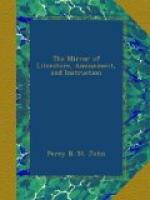“The present differs from the earlier carriage, in several improvements in the machinery, suggested by experiment; also in having no propellers;[2] and in having only four wheels instead of six; the apparatus for guiding being applied immediately to the two fore-wheels, bearing a part of the weight, instead of two extra leading wheels bearing little or none. No person can conceive the absolute control this apparatus gives to the director of the carriage, unless he has had the same opportunities of observing it which I had in a ride with Mr. Gurney. Whilst the wheels obey the slightest motions of the hand, a trifling pressure of the foot keeps them inflexibly steady, however rough the ground. To the hind axle, which is very strong, and bent into two cranks of nine inches radius, at right angles to each other, is applied the propelling power by means of pistons from two horizontal cylinders. By this contrivance, and a peculiar mode of admitting the steam to the cylinders, Mr. Gurney has very ingeniously avoided that cumbersome appendage to steam-engines, the fly-wheel, and preserves uniformity of action by constantly having one cylinder on full pressure, whilst the other is on the reduced expansive. The dead points—that is, those in which a piston has no effect from being in the same right line with its crank,—are also cleared by the same means. For as the cranks are at right angles, when one piston is at a dead point, the other has a position of maximum effect, and is then urged by full steam power; but no sooner has the former passed the dead point, than an expansion valve opens on it with full steam, and closes on the latter. Firmly fixed to the extremities of the axle, and at right angles to it, are the two ’carriers’—(two strong irons extending each way to the felloes of the wheels.) These irons may be bolted to the felloes of the wheels or not, or to the felloes of one wheel only. Thus the power applied to the axle is carried at once to the parts of the wheels of least stress—the circumferences. By this artifice the wheels are required to be of no greater strength and weight than ordinary carriage-wheels; and, like them, they turn freely and independently on the axle; but one or both may be secured as part and parcel of the axle, as circumstances require. The carriage is consequently propelled by the friction or hold which either or both hind-wheels, according as the power is applied to them jointly or separately, have on the ground. Beneath the hind part drop two irons, with flat feet, called ‘shoe-drags.’ A well-contrived apparatus, with a spindle passing up through a hollow cylinder, to which the guiding handle is affixed, enables the director to force one or both drags tight on the road, so as to retard the progress in a descent, or if he please, to raise the wheels off the ground. The propulsive power of the wheels being by this means destroyed, the carriage is arrested in a yard or two, though going at the rate of eighteen or twenty miles an hour. On the right hand of the director lies the handle of the throttle-valve, by which he has the power of increasing or diminishing the supply of steam ad libitum, and hence of retarding or accelerating the carriage’s velocity. The whole carriage and machinery weigh about 16 cwt., and with the full complement of water and coke 20 or 22 cwt., of which, I am informed, about 16 cwt. lie on the hind-wheels.”




